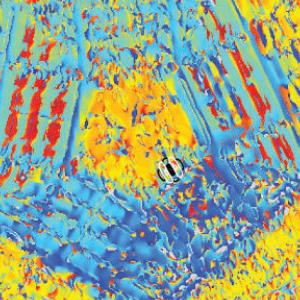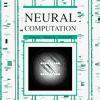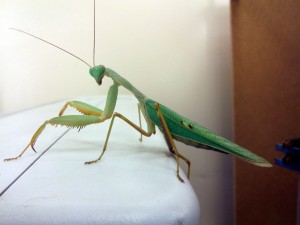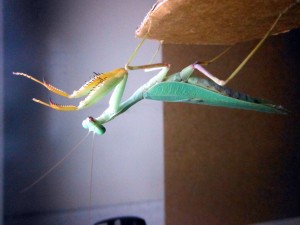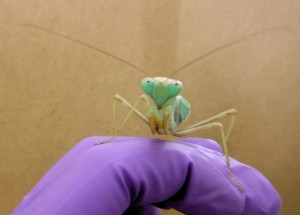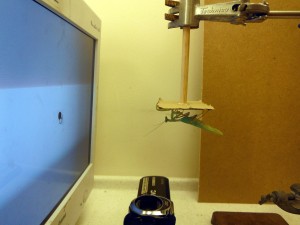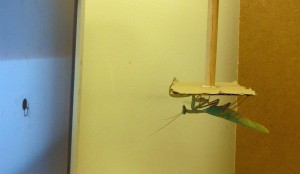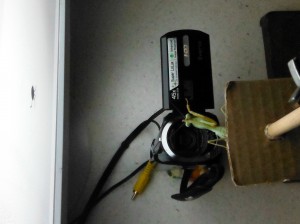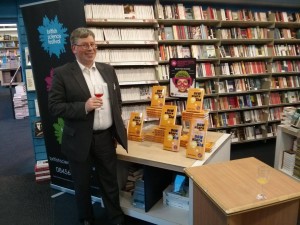 Anyone interested in the history of science in general and astronomy in particular can pick up a copy of my husband Marc’s book from the Newcastle branch of Blackwell’s on Percy Street. “New Stars for Old” is a series of linked short stories featuring characters from Aristotle to Newton, bringing to life the story of humanity’s attempt to understand the cosmos.
Anyone interested in the history of science in general and astronomy in particular can pick up a copy of my husband Marc’s book from the Newcastle branch of Blackwell’s on Percy Street. “New Stars for Old” is a series of linked short stories featuring characters from Aristotle to Newton, bringing to life the story of humanity’s attempt to understand the cosmos.
Author Archives: Jenny
Welcome Vivek!
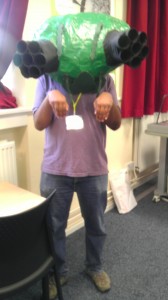
Delighted to say it was Vivek’s first day in the lab today. And he brought a delicious carrot cake along too! It was like the old days when Jennifer would bring along cake for lab meetings :).
Vivek wasted no time getting stuck in. He hasn’t even been given his computer log-in yet, but so far today he’s helped present a workshop on insects to local teens and worked with Ghaith on getting the mantids to strike at various visual stimuli. Oh, and he got transformed into a Kafkaesque man-insect hybrid. Not bad for one’s first day in a new job…
Day 2 of the British Science Festival
…and I am feeling I need a lie-down! All I did today was help present three 45-minute workshops to a total of nine groups of half a dozen kids. I realise this is nothing compared to the daily workload of a teacher, so all I can say to any teachers reading this is: Respect.
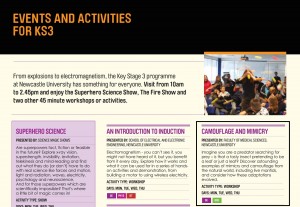
Today was the first day I had seen the workshop in operation, as I was tied up with a different event yesterday, and I was blown away by what a great event Lisa and Corry had organised (see inset image of the programme).
Everything ran very smoothly with expert presentation from Helen and Mandy, and the students (aged 11-14) seemed to really enjoy the different activities.
Corry had created an incredible giant sculpture of a praying mantis from translucent green acrylic. I don’t know what’s going on optically, but it really appears to glow with an inner light! Just incredible.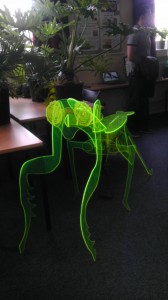
Lisa had made a papier-mache mantis head to demonstrate how insects see through compound eyes, which everyone enjoyed trying on.
We were all impressed by what a natural teacher Paul is: “Right! Front row is red group, you’re with Helen doing the experiment. Middle row, you’re blue group, you’re with me over here” – friendly but with a natural authority; great stuff.
Yesterday, I gave a short talk on 3D vision as part of a set of linked talks on perception (More than meets the eye, organised by Quoc Vuong and Debbie Riby). That seemed to go well, with engaged and perceptive questions from the audience. I also had a major grant submission deadline 30 minutes before my talk started, so that together with organising my contribution to the camouflage workshop made for a busy time. Thanks everyone for rallying round — I’ve been making a nuisance of myself texting various lab-members with pleas for help: “James can you go into town and get a 3D Blu-Ray”, “Paul can you pick up my poster on insect vision”, “Ghaith argh my camouflage-breaking stereo demo has broken, please fix it!” Thanks everyone for rallying round and keeping the various shows on the road.
Satisfied.
What a productive lab… Lisa and Paul gave great talks as part of their MRes yesterday; today Lisa is delivering multiple talks to visiting sixth-formers as part of Biology Open Day, while Paul is up in Edinburgh on a Matlab course. Nick and Mike are working hard on their interim reports, due in tonight, while Parto is relieved to have finally got her visa renewal confirmed and is collecting control data with a lighter heart. James and I had a very useful meeting with colleagues this morning on taking the smartphone work further. Ghaith only started work with us on Wednesday and from what I see when I walk past his desk, is already making brilliant progress automating the video analysis. How fab to be part of such a talented and motivated team!
Mantis migration
Thanks everyone who came along to help Lisa and me move our mantids across to their new home in the dedicated insect facility down the road. Especially Nick and Mike, who probably didn’t imagine when they came to the UK to do a MSc in Computer Games Engineering that this would involve transporting predatory insects! Although Nick — how about doing us a giant mantis in stereoanamorphic perspective? How scary would that be?
Psychtoolbox MakeTexture
I was just having a problem with MakeTexture in Psychtoolbox. I like to use
PsychImaging(‘AddTask’, ‘General’, ‘NormalizedHighresColorRange’);
so that black=0 and white=1, not 255. This makes my code transfer easily to high-bit-depth devices like my DATAPixx. But I was having a problem that MakeTexture would only work with the 0-255 colour range. Argh what a pain! But thankfully googling revealed that this was my mistake.
“— In psychtoolbox@yahoogroups.com, “IanA”
Answering my own question, I realised after I posted it that MakeTexture
requires a bitdepth passed to it explicitly, and then the normalised range works
as expected. I had expected the default (0) to follow the window itself, but
reading the documentation properly 😉 see the default is 8bit.
Ian
”
So I just needed to do
tex=Screen(‘MakeTexture’, window, imageMatrix,[],[],1);
instead of
tex=Screen(‘MakeTexture’, window, imageMatrix);
and it all worked. Love Psychtoolbox!
Makerspace
Dropped into the Newcastle Makerspace last night and had a friendly welcome. Definitely need to start going to that and getting creative in a geeky way.
Picturing science
Our energetic team submitted a number of entries to the Royal Society’s Picturing Science competition.
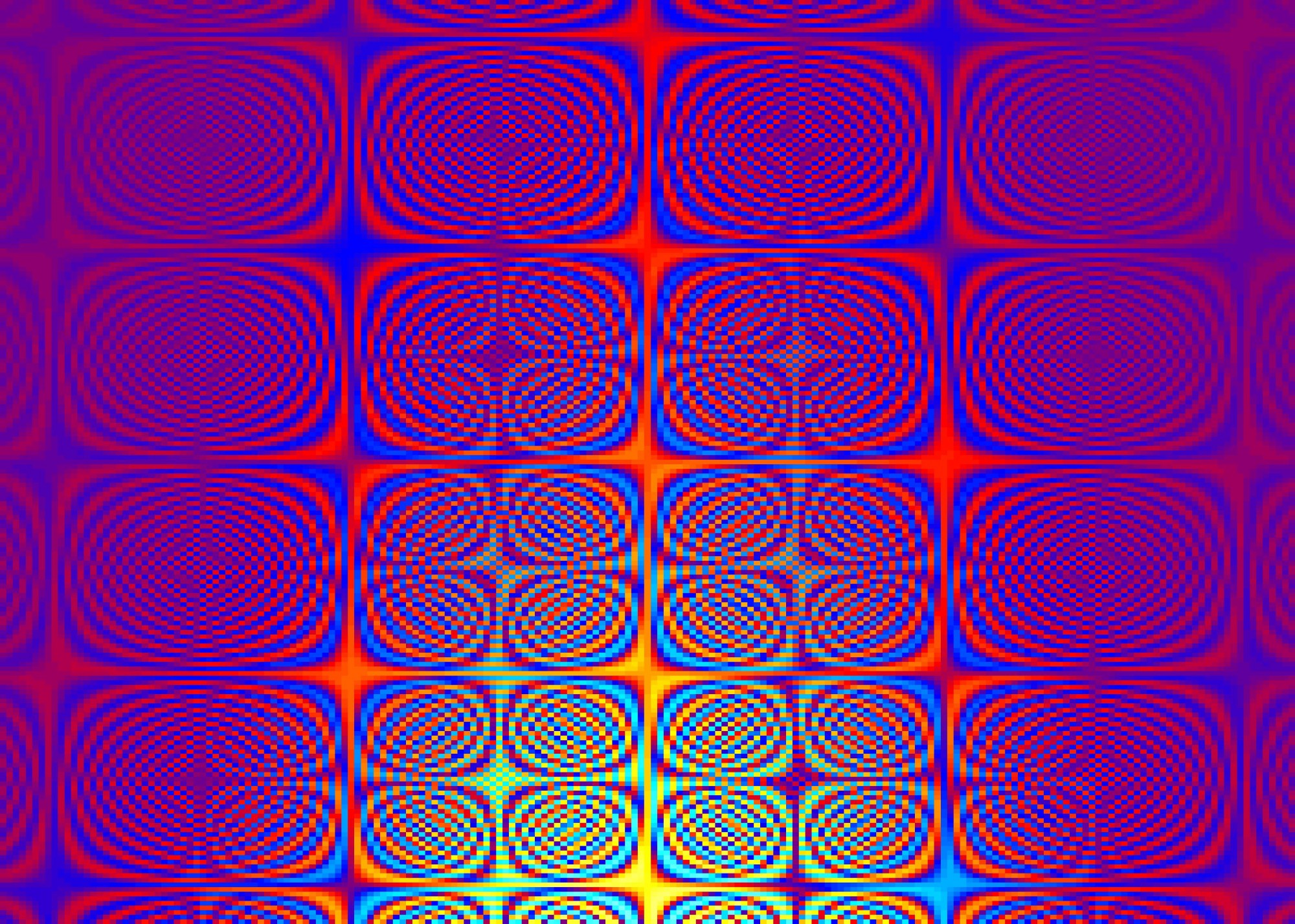
Jenny: This is an image I created in the scientific programming environment Matlab while doing some maths, trying to understand a particular aspect of stereo ("3D") vision. The funny thing is that I can now no longer even remember how I generated it! I think it is probably a Fourier phase spectrum of some sort. I threw up this image in my work, saved the figure, and carried on. Much later I came back to it and was struck by how beautiful and complex it is. In its repeating cells of interlocking curves, it reminds me of Celtic knotwork like that found in the Lindisfarne gospels.
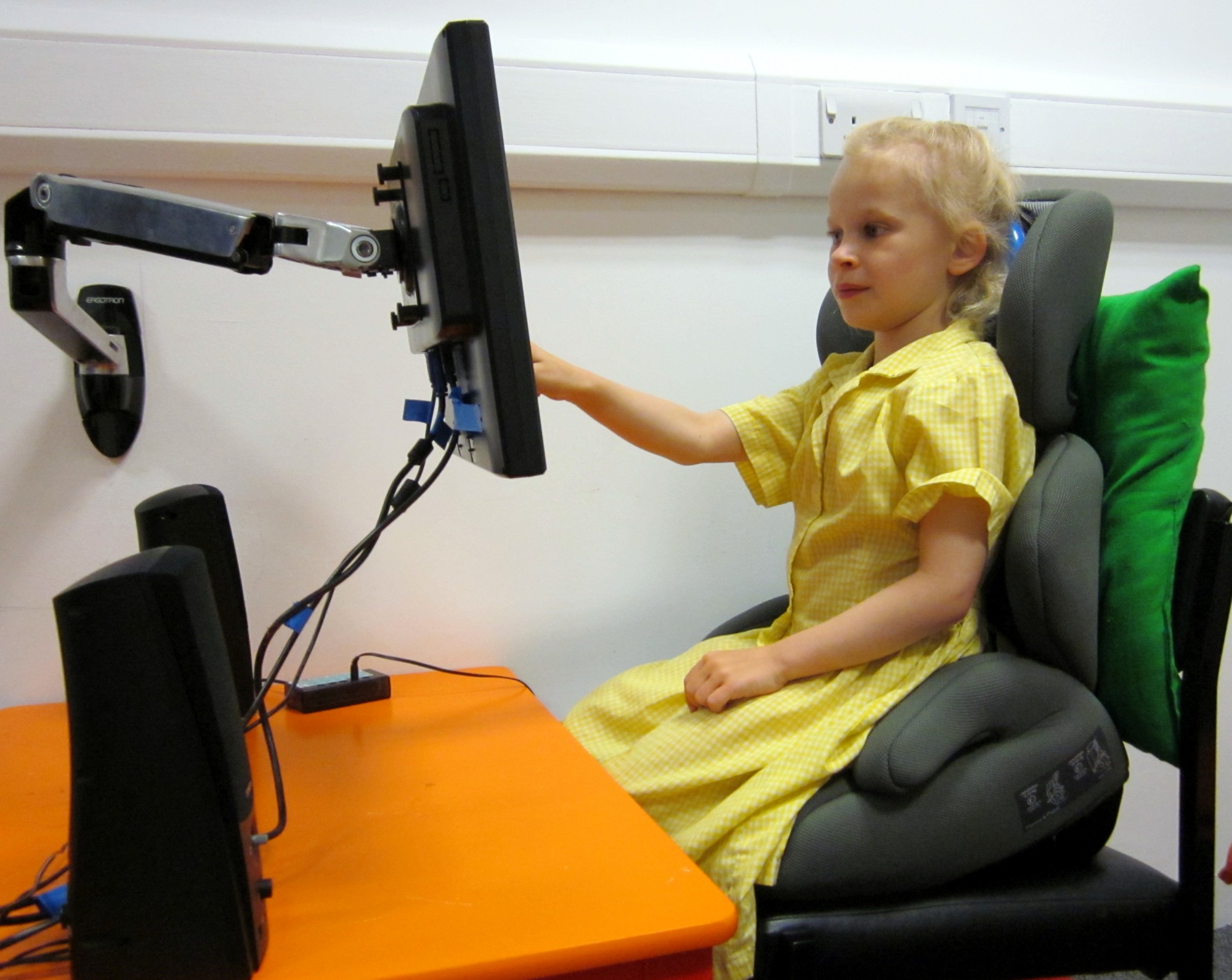
Jenny: A occupational hazard of being a scientist's daughter is being roped into experiments. For this project, we were interested in where children looked when making judgments about pictures. We developed a system where we displayed pictures to children on a computer touchscreen; the children's eye-movements as they scanned the picture were monitored by an eye-tracker in front on them, and the children then touched the screen to indicate their judgment. We had the children sit on a carseat so that their head stayed in roughly the same position and the eyetracker didn't lose sight of their eyes. An adjustable arm helped us position the touchscreen at the right distance for each child, while the company Tracksys kindly loaned us an eyetracker. My little girl helped us get it all working and patiently recorded the words we needed for the experiment, so the computer could "speak" in a nice, friendly child's voice.
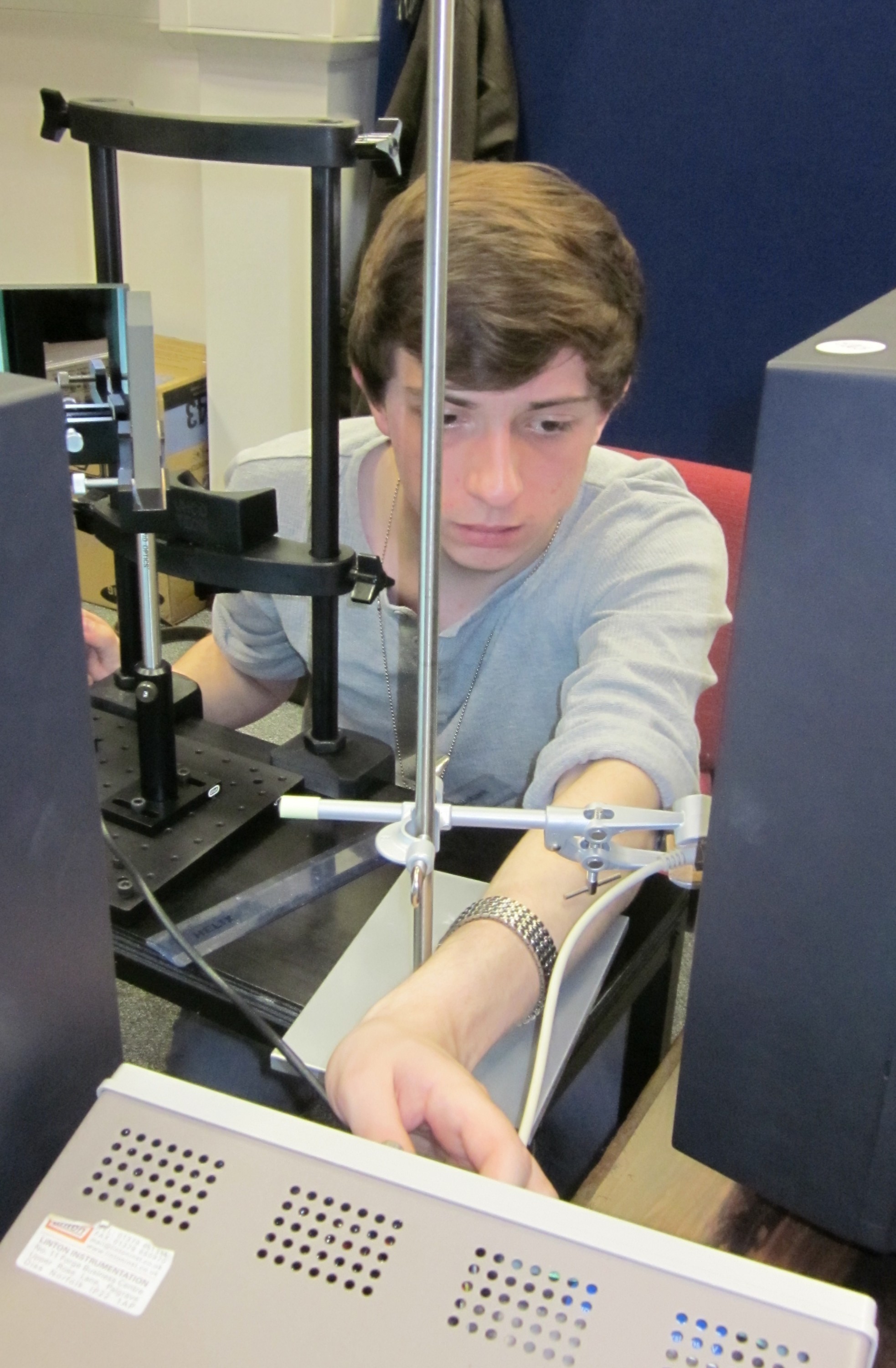
Jenny: This photo shows undergraduate student Steven Errington checking the calibration of a mirror stereoscope. This is one of the oldest forms of 3D display, and uses mirrors to present different images to the two eyes. The observer will sit with their head in the headrest in front of Steven, and the two mirrors in front of them will ensure that their left eye views a computer monitor to their left, while their right eye views a different monitor on their right. It's essential the two monitors are aligned both in space and time - that is, that they update their images at exactly the same time. Steven has clamped a photodiode in front of each monitor (that's the white cable running down by his hand) and fed their inputs into an oscilloscope. Photodiodes output a voltage which depends on the light falling onto them, so each new image presented on the computer monitor shows up as a "blip" on the oscilloscope. Steven can then check that the blips are occurring at exactly the same time, to sub-millisecond precision.
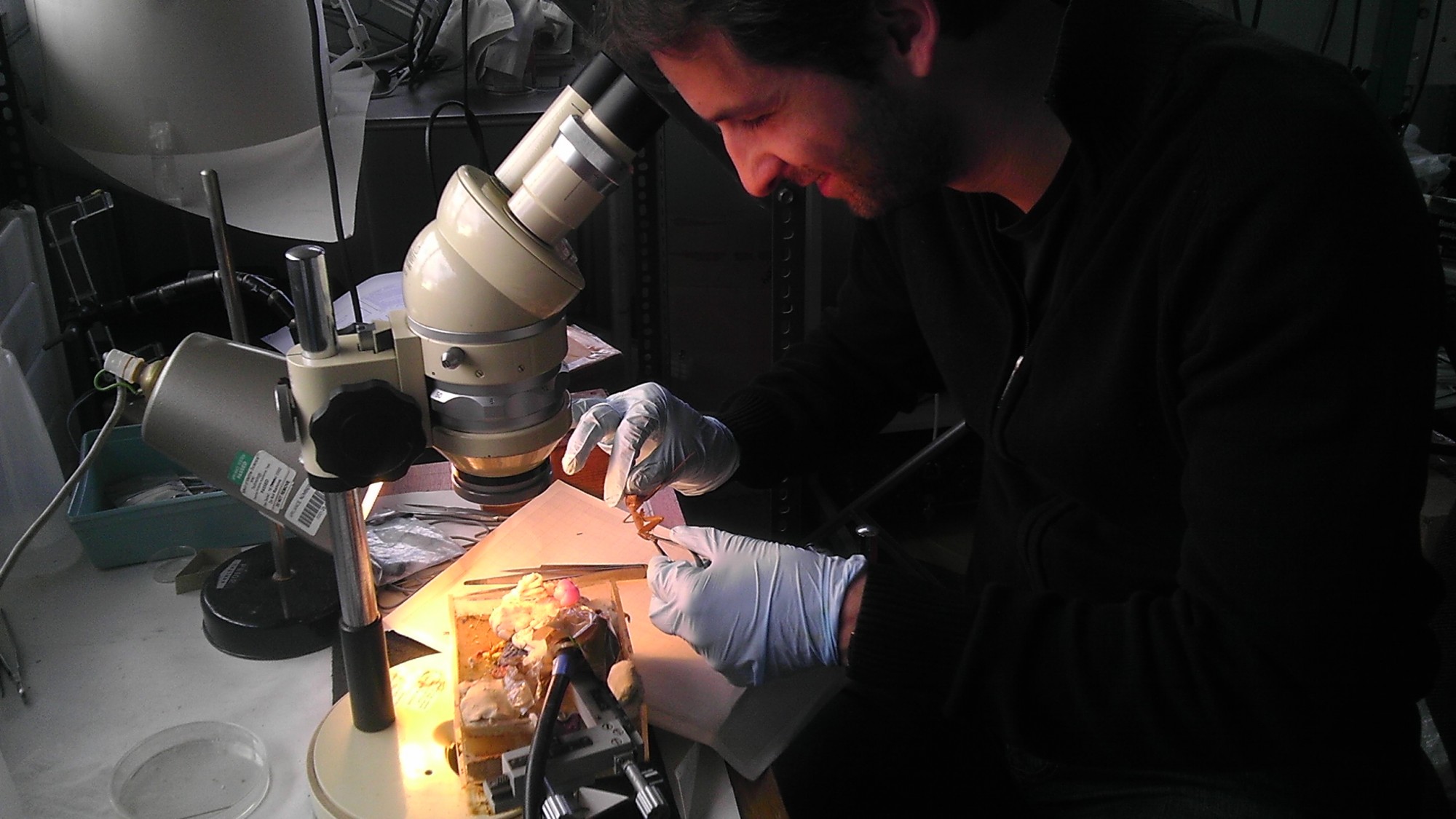
Jenny: Dr Ronny Rosner, an expert in insect visual neurophysiology, prepares to dissect a praying mantis in Dr Claire Rind’s insect lab at Newcastle University. This is part of a major new project in my lab, “Man, Mantis and Machine”, funded by the Leverhulme Trust. The praying mantis is the only non-vertebrate known to have a form of 3D vision, which it uses to help it strike at prey. We want to understand the neuronal circuits in its brain which help it do this, in order to compare them to similar circuits in human beings and other animals, and to 3D vision algorithms in computers and robots. Ronny will be joining my lab next year to bring his expertise to bear on these questions.
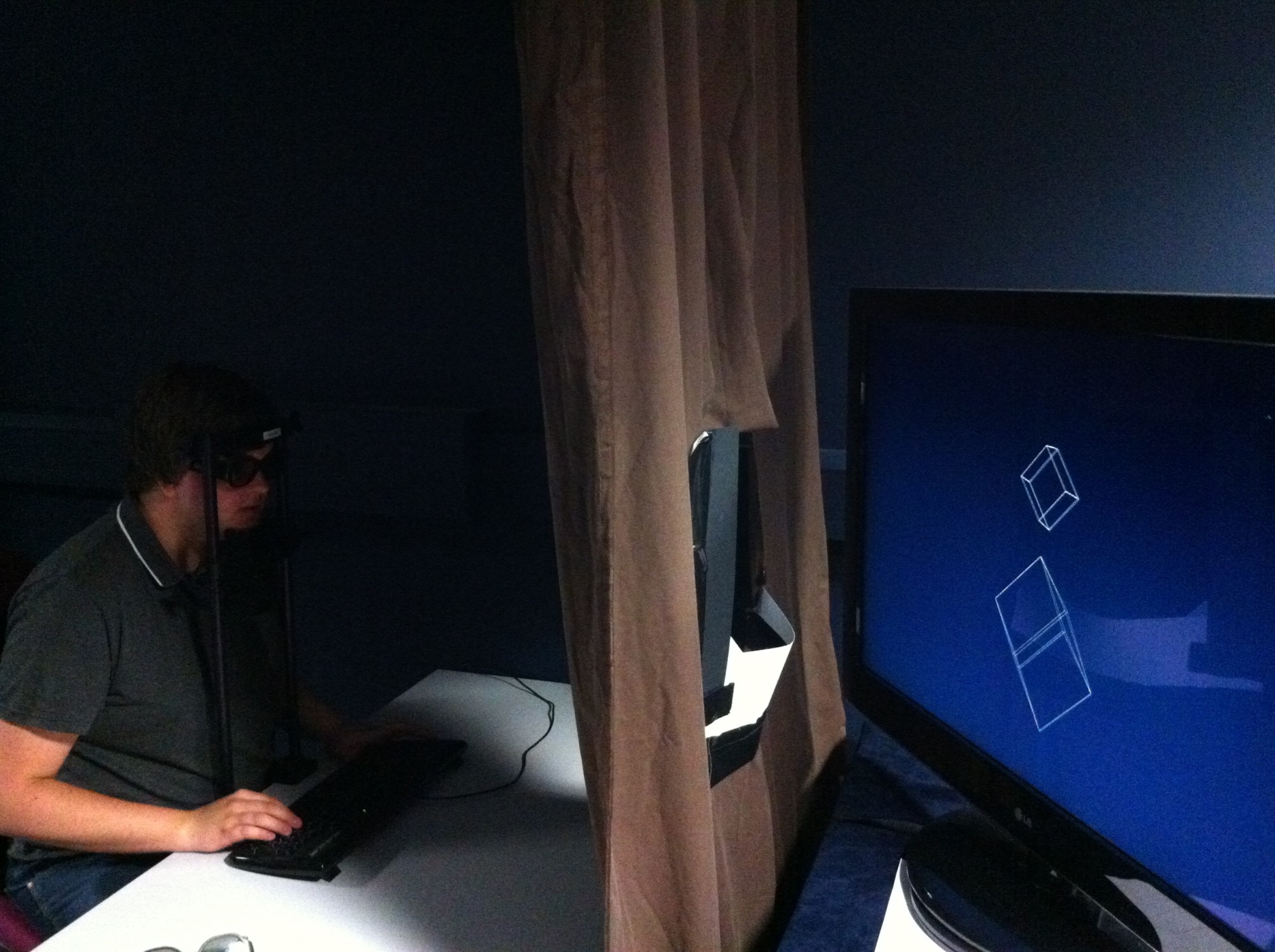
Paul: This experiment is designed to test orientation cues with stereo 3D (S3D) displays. The subject is sat behind a curtain with a square cut out of it, and can’t see that the television is in fact twisted through an angle, and therefore not perpendicular. However because of the display being S3D the subject cannot distinguish this change in orientation and assumes that the screen is frontoparallel (perpendicular). This means that when we show the stimulus (in this experiment a pair of rotating cubes) the stimulus look warped unless they are projected for the angle the subject is sat at (orthostereo), in contrast to when the curtain is removed and the television can be seen to be rotated, at which point the subjects brain corrects for not being perpendicular and sees the orthostereo cube (rendered for the angle) as warped, and the perpendicular cube as correctly projected.
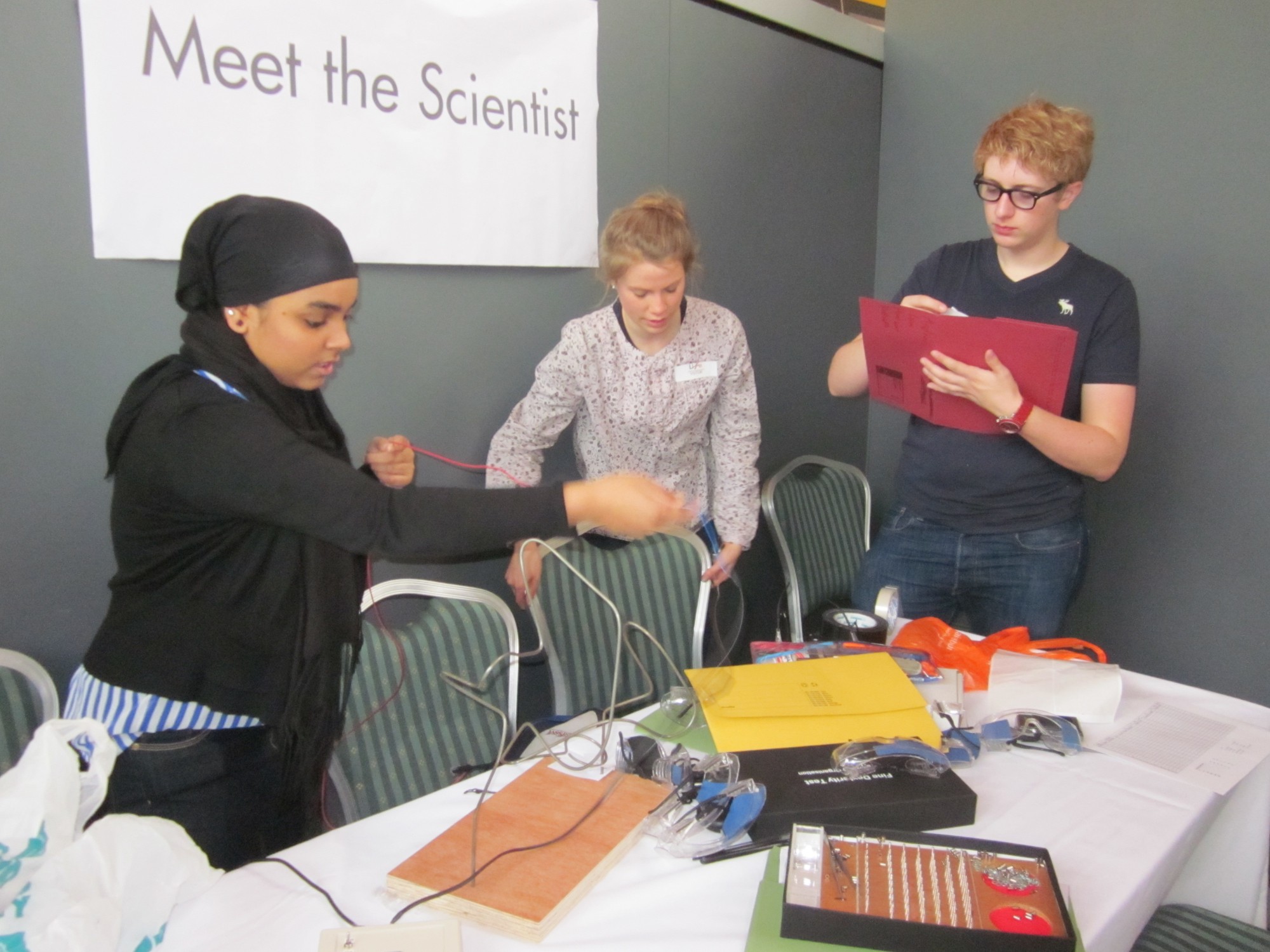
Jenny: Three local sixth-formers did a summer project in my lab, funded by the Nuffield Foundation. As part of this, they collected experimental data from members of the public in Newcastle's Centre for Life. Here, they are getting their equipment set up ready for another busy data running experiments. Their work ended up being published in two scientific papers, on which the young people were authors, both in the journal i-Perception.
Welcome Ronny!
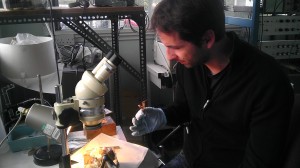 And I’m delighted to announce that Ronny Rosner is the third and final member of the M3 team. Ronny already has considerable experience studying neuronal processing by both behavioural and electrophysiological approaches in flies and locusts, including both extracellular and intracellular recordings. He’s currently in Uwe Homberg’s lab in Marburg, Germany. Ronny won’t be joining us till January 2014, though he will be visiting before then. He’s already spent a week visiting Newcastle, during which I took this photo of him in Claire Rind’s lab, about to dissect a mantis brain for us. Germany has a particularly strong tradition of insect neuroscience, so I’m delighted Ronny will be bringing that over to Newcastle to fuse with our existing insect and wider neurophysiology community. In fact I am really excited that I’ve managed to recruit such a talented team for the M3 project, and am looking forward eagerly to 5 years of fun science and productivity!
And I’m delighted to announce that Ronny Rosner is the third and final member of the M3 team. Ronny already has considerable experience studying neuronal processing by both behavioural and electrophysiological approaches in flies and locusts, including both extracellular and intracellular recordings. He’s currently in Uwe Homberg’s lab in Marburg, Germany. Ronny won’t be joining us till January 2014, though he will be visiting before then. He’s already spent a week visiting Newcastle, during which I took this photo of him in Claire Rind’s lab, about to dissect a mantis brain for us. Germany has a particularly strong tradition of insect neuroscience, so I’m delighted Ronny will be bringing that over to Newcastle to fuse with our existing insect and wider neurophysiology community. In fact I am really excited that I’ve managed to recruit such a talented team for the M3 project, and am looking forward eagerly to 5 years of fun science and productivity!
Mantid photos
Lisa’s been taking more fab photos of the mantids. They are so cool!
Here are some photos showing our experimental set-up.




